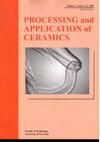Thermoelectric properties of CaMnO3 ceramics produced by using powder synthesized by modified Pechini method
IF 0.8
4区 材料科学
Q3 MATERIALS SCIENCE, CERAMICS
引用次数: 2
Abstract
Calcium manganate (CMO) is a promising n-type semiconductor for thermoelectric applications due to its intrinsic properties. Still, these properties are highly dependent on the processing route used to produce these materials. In this work, properties of the polycrystalline CMO ceramics are reported by studying samples obtained from powders synthesized by a modified Pechini method and sintered at 1543K for 1, 3, 6, 12 and 24 h. Crystallographic parameters of the resulting phases were determined from X-ray diffraction patterns. The ceramics sintered for 6 h has the highest density (94.8%TD), while the CMO-1h sample (sintered only 1 h) presented the lowest density (77.2%TD) due to a large amount of secondary phase and short sintering time. The crystallite sizes of the CMO particles reached 49.2 nm; meanwhile, the grain sizes were in the range from 1.04 to 4.85 ?m. Seebeck coefficient has a negative value, characterizing an n-type material, and its value approached ?350 ?V/K at 873K. The sample sintered for 1 h has the lowest value of thermal conductivity (3.3W/mK), while the ceramics sintered for 3 h reached maximum electrical conductivity value (1830 S/m), both at 873K. In addition, this high conductivity of the ceramics sintered for 3 h contributed to it having the highest ZT value of about 0.039.改性Pechini法合成粉体制备CaMnO3陶瓷的热电性能
锰酸钙(CMO)是一种很有前途的热电n型半导体材料。尽管如此,这些特性高度依赖于用于生产这些材料的加工路线。本文研究了用改进的Pechini方法合成的粉末,在1543K下烧结1、3、6、12和24小时,得到的CMO多晶陶瓷的性能。通过x射线衍射图确定了所得相的晶体学参数。烧结时间为6 h的陶瓷密度最高(94.8%TD),而烧结时间为1h的CMO-1h样品密度最低(77.2%TD),主要是由于二次相较多,烧结时间短。CMO颗粒的晶粒尺寸达到49.2 nm;晶粒尺寸在1.04 ~ 4.85 μ m之间。塞贝克系数为负值,为n型材料,873K时塞贝克系数接近350v /K。烧结1h试样的导热系数最低(3.3W/mK),烧结3h陶瓷的导热系数最高(1830 S/m),均为873K。此外,烧结3 h的陶瓷的高导电性使其ZT值最高,约为0.039。
本文章由计算机程序翻译,如有差异,请以英文原文为准。
求助全文
约1分钟内获得全文
求助全文
来源期刊

Processing and Application of Ceramics
MATERIALS SCIENCE, CERAMICS-
CiteScore
1.90
自引率
9.10%
发文量
14
审稿时长
10 weeks
期刊介绍:
Information not localized
 求助内容:
求助内容: 应助结果提醒方式:
应助结果提醒方式:


